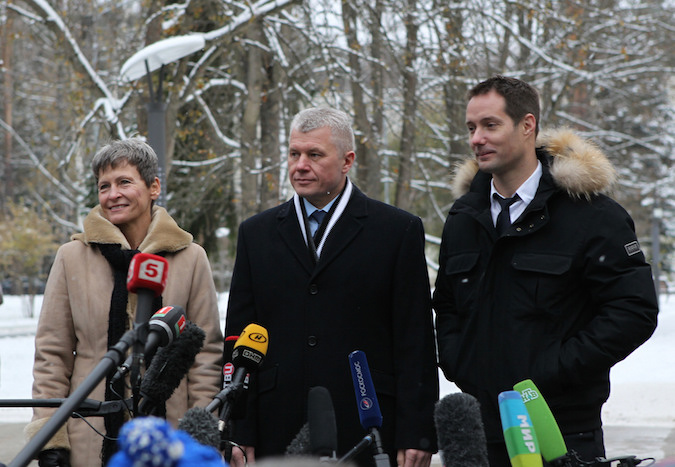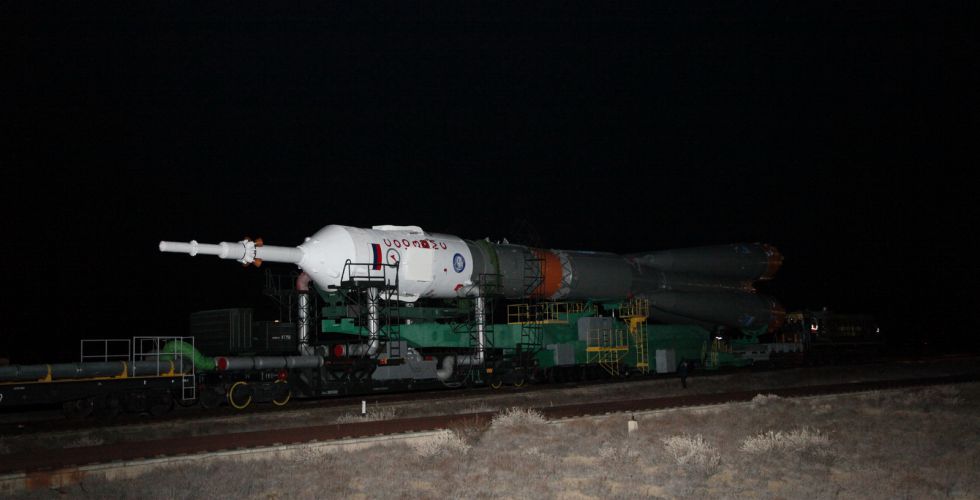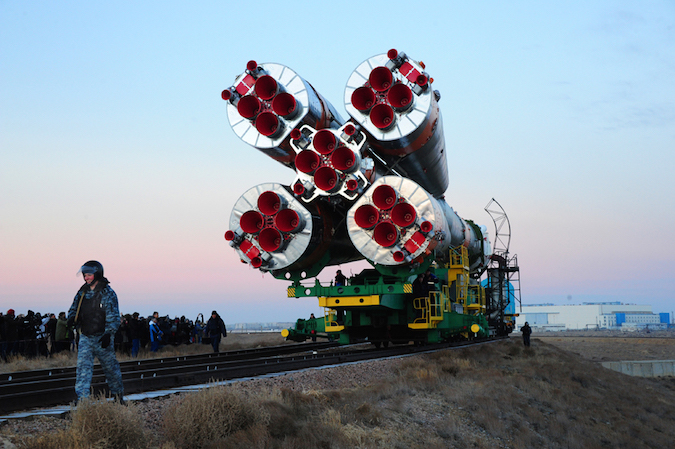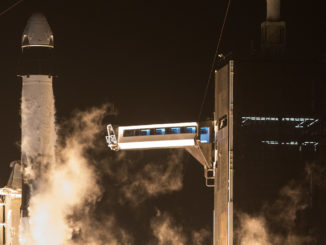The Soyuz booster that will send the International Space Station’s next three residents into orbit later this week rolled out of an integration hangar early Monday and rode a railroad car to its launch pad at the Baikonur Cosmodrome in Kazakhstan.
The rocket will lift off at 2020 GMT (3:20 p.m. EST) Thursday from Baikonur, heading to orbit on a two-day chase of the space station, setting up for a radar-guided rendezvous and docking Saturday.
The Soyuz MS-03 spaceship, the third in a line of upgraded Russian crew capsules, will take the longer two-day route to the space station to continue tests of the modernized spacecraft. In recent years, Russia has typically launched Soyuz crews on a six-hour rendezvous trajectory, allowing the craft to reach the complex on the same day as launch.
Continuing a tradition dating back to the dawn of the Space Age, the Soyuz rocket emerged from its hangar at Baikonur mounted on a transport train for the trip to the launch pad.
The rollout Monday came a day after technicians installed the Soyuz capsule on the front end of the rocket. Last week, ground crews placed an aerodynamic fairing, which will jettison a few minutes into the flight, over the Soyuz spacecraft before moving the vehicle to the rocket assembly hangar.
Russian cosmonaut Oleg Novitskiy, a 45-year-old Russian Air Force pilot and native of Belarus, will occupy the center seat of the Soyuz MS-03 spacecraft as commander. About to fly to the space station for the second time, Novitskiy spent 143 days in orbit on the Expedition 33 and 34 mission in 2012 and 2013.
In the capsule’s left seat will be French astronaut Thomas Pesquet, a European Space Agency astronaut who will serve as Novitskiy’s co-pilot during the flight to the space station. Pesquet, 38, was a spacecraft engineer at CNES, the French space agency, and an Air France commercial airline pilot before his selection as an astronaut in 2009.
Veteran NASA astronaut Peggy Whitson, 56, will launch in the the right seat of the Soyuz spaceship on her third spaceflight. Whitson first lived on the space station as a flight engineer and science officer on the Expedition 5 mission in 2002, the launched again in 2007 to command the Expedition 16 mission.
Whitson, a native of Iowa, has accumulated more than 376 days in space during her two previous flights.
Docking of the Soyuz MS-03 spacecraft with the station’s Rassvet module on Saturday is scheduled for around 2201 GMT (5:01 p.m. EST). Expedition 50 commander Shane Kimbrough and flight engineers Sergey Ryzhikov and Andrey Borisenko will welcome the three new crew members.
Whitson will command the station’s Expedition 51 crew next year after the departure of Kimbrough, Ryzhikov and Borisenko.
The Soyuz MS-03 spacecraft will remain docked to the space station until April or May.

The arrival of the three fresh residents will kick off a busy couple of months on the space station.
“There will be quite a bit of traffic and crew time associated with that,” said Sam Scimemi, NASA’s space station program director at NASA Headquarters.
An Orbital ATK Cygnus cargo craft that arrived at the outpost in October is set to depart the complex Nov. 21 with a load of trash. Before heading for a destructive re-entry, the Cygnus supply ship will deploy several CubeSats and conduct a fire experiment inside a self-contained box within the craft’s pressurized module.
A Russian Progress cargo and refueling freighter is set for launch Dec. 1 from Baikonur, with docking expected Dec. 3.
Then a Japanese HTV supply mission will blast off aboard an H-2B rocket Dec. 9, setting up for its automated rendezvous and capture with the space station’s robotic arm Dec. 13.
The HTV mission will deliver six lithium-ion batteries to kick off a multi-year effort to replace the space station’s aging nickel-hydrogen battery system. The battery changeout will require at least two spacewalks in January, and perhaps as many as four EVAs if astronauts run into any trouble.
“During the next increment, they will be busy,” Scimemi said Monday during a meeting of the NASA Advisory Council’s human exploration and operations subcommittee. “There are going to be some challenges. We’ve got two EVAs scheduled to install the batteries, and another couple of EVAs as contingency if they don’t go so well.”
Other activities, aside from a heavy slate of science experiments, will include maintenance on the station’s carbon dioxide removal assembly, activation of a new galley, and preparations to relocate a docking port on the complex, Scimemi said.
Photos of the Soyuz rocket’s rollout Monday are posted below, including images of the launch pad’s gantry towers enclosing the booster backdropped by nearly full moon.




















Email the author.
Follow Stephen Clark on Twitter: @StephenClark1.



